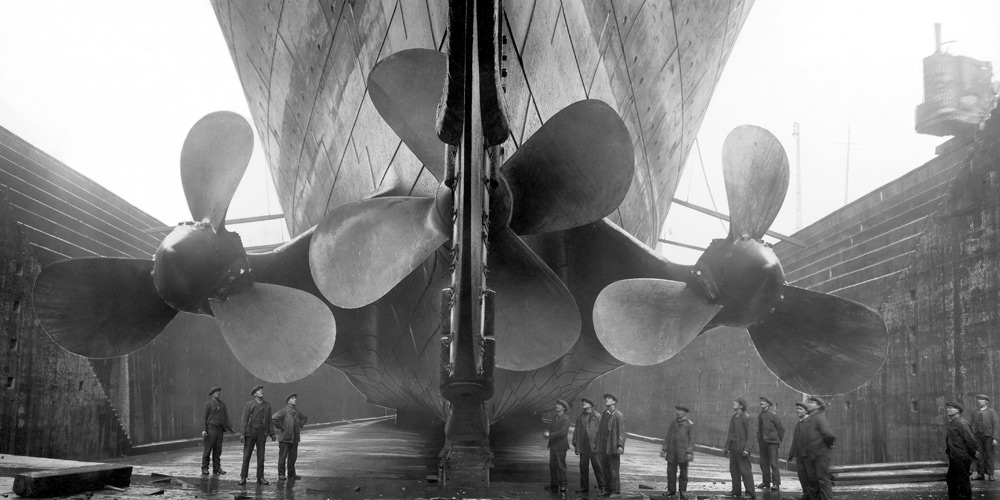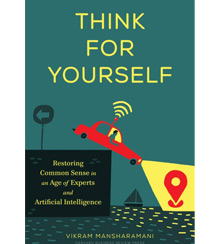How fiction can help us imagine the future
In an age of big data, artificial intelligence, and continual forecasting, fiction can help us navigate uncertainty by opening our eyes to a wide range of scenarios.
Morgan Robertson was a former cabin boy in the merchant marine, had tired of sea life, spent a decade as a diamond setter, and eventually turned to writing stories about life at sea. He never made much money and died at the age of 53 from an overdose. Before he died, Robertson wrote a novel called Futility about “the largest craft afloat and the greatest of the works of men.” The vessel was the embodiment of “every science, profession, and trade known to civilization” and was a modern-day technological marvel. Deemed unsinkable, it attracted famous people from around the world to journey across the Atlantic in unrivaled comfort and style. Nineteen watertight compartments ensured the ship’s buoyancy, as she could continue to sail with nine of them flooded. And because the vessel was deemed indestructible, it carried an inadequate number of lifeboats — enough to handle only one-sixth of the passengers aboard. The name of the ship was the Titan. In Robertson’s tale, on a voyage through the North Atlantic one April, the ship struck an iceberg and sank. The story describes the drama associated with a disgraced naval officer who worked as a deckhand on the Titan, John Rowland. Rowland ends up rescuing a young girl but is later accused by the girl’s mother (who happens to have been his former lover) of kidnapping her.
Given that authors often look to historical events for inspiration, you might dismiss Robertson’s novel as being in the same vein as James Cameron’s blockbuster 1997 movie Titanic. But Futility was written 14 years before the actual Titanic sank. After the sinking of the actual Titanic, Robertson was celebrated by many as a clairvoyant, possessing extraordinary skills of precognition. After all, aside from the similarities of name and method of demise, consider the uncanny coincidences (see “The Wreck of the Titan, or Futility versus the Titanic”). He dismissed these claims, suggesting it was his knowledge of maritime matters that gave him the ability to write about ships with detail. Yet the world refused to give up on the possibility that he had in fact seen the future.
Coincidences happen, for sure. And anyone prognosticating has likely heard the clichés “Even a broken clock is right twice a day” or “Every now and then a blind squirrel will find a nut.” In fact, Robertson’s title hints at the primary criticism regularly hurled at those thinking about the future — it’s an act of futility. As the common saying goes, “It’s dangerous to make predictions, especially about the future.” One need only look to expert predictions to see just how inaccurate predictions can be. The Great Depression of 1990, by Southern Methodist University economist Ravi Batra (which stayed on the bestseller list for 10 months in hardcover and more than 19 months as a paperback), totally missed the technological developments that made the 1990s among the most productive decades ever. Nobel laureate Ken Arrow captured the desire for predictions quite eloquently in recalling his work for the U.S. Army Air Force. Despite concluding that the weather predictions upon which the superiors relied were entirely useless (i.e., statistically random, no better than a guess), he was rebuffed, being told that “The commanding general is well aware that the forecasts are no good; however, he needs them for planning purposes.”
As comical as that statement sounds, I find it quite useful — and helpful. The blunt reality is that accuracy cannot and should not be the criterion upon which to evaluate thinking about the future. Usefulness, I propose, is a far better standard. Just as it’s impossible to evaluate the quality of a decision process by its outcome, so too is it unproductive to evaluate the quality of a prediction by its accuracy.
The blunt reality is that accuracy cannot and should not be the criterion upon which to evaluate thinking about the future.
As we face unprecedented levels of uncertainty in our personal and professional lives, we have to learn to embrace it and develop the skills to navigate through it. In an age in which we outsource so much of our thinking to algorithms, big data, and experts, it is vital that we reclaim the ability to think for ourselves. And in this regard, it’s worth looking to the work of people who imagine the future. Considering alternative future possibilities for how the world may unfold can help us navigate the complexity in our lives. Entertaining a wide range of outcomes can help nudge us away from our default position and widen our view of the possibilities ahead. In fact, thinking about various scenarios, stories of possible futures, may be the most useful way to support decision making in the face of radical uncertainty.
Scenario planning
There is a long history behind the use of scenarios as a means to navigate uncertainty. The practice really began with Herman Kahn, who took military scenario planning from the U.S. Air Force and tried to adapt it to the business context. A systems thinker, Kahn cofounded the Hudson Institute and gained prominence as a strategist at the Rand Corporation thinking about nuclear war. In 1967, he and colleague Anthony Wiener penned The Year 2000: A Framework for Speculation on the Next Thirty-Three Years. In 1976, he and some colleagues wrote a book titled The Next 200 Years: A Scenario for America and the World. One of the stories Kahn painted, which at the time might have seemed a bit far-fetched, was that South Korea — one of the poorest countries in the world in the 1970s — would emerge as an economic powerhouse by the turn of the century.
If Kahn is the father of modern scenario planning, Pierre Wack is the son who took its usefulness to new heights in the business community. Wack and his colleagues in the group planning department at Royal Dutch/Shell understood the price of oil was critical for their business, but because the price had been relatively steady for long periods of time, few worried about it. The planners thought this was a flawed way to think about the future and in the early 1970s began developing stories of possible scenarios that might affect the oil price. One scenario involved the newly formed Organization of Petroleum Exporting Countries (OPEC) flexing its muscles, with huge ramifications for the oil price. When the 1973 Yom Kippur War led to an oil price shock, Shell was more prepared than most because its managers had already thought through how to act in such a world. Peter Schwartz, who also served in the group planning department at Shell, summarized the value of the scenarios used by Shell in The Art of the Long View: “The end result…[was] not an accurate picture of tomorrow, but better decisions about the future.”
The experience of Shell shows that we need not be surprised by future developments. In fact, by hiding from the uncertainty rather than embracing it, we might miss obvious risks and forgo tremendous opportunities. After all, everyone is capable of imagining scenarios that may or may not transpire. To be sure, unadulterated imagination will produce some wacky thoughts. But some of them may prove to be revolutionary. We need to scatter our thinking with lots of experiences so that we have them to draw upon when needed. For this reason, in the past decade, I’ve taken to regularly reading fiction and watching films to help me imagine different worlds, possible scenarios, and alternative futures. In fact, whereas I once felt guilty about watching movies in the middle of the day, I’ve done so (without remorse!) a couple of times when I find my thinking in a rut. Stories tend to help us get out of our own heads and to think about scenarios that may not naturally enter our frame of view. For, as Jessamyn West once said, “fiction reveals truths that reality obscures.”
One of the more powerful novels I’ve read was written by William R. Forstchen, a military historian. One Second After, published in 2009, explores the possibility of a United States crippled by an electro-magnetic pulse (EMP) attack that knocks out the electrical power infrastructure. In the foreword, former speaker of the house Newt Gingrich describes the book as a “‘future history’ that might come true.” I’ve even used the book in the class I teach on systems thinking to illustrate the dependency we have developed on certain critical infrastructure and how many of our social, cultural, economic, and political systems might break down. The book paints such a visceral image of what life might be like in the event of an EMP attack that I would never have understood or imagined the full impact without reading the detailed scenario as presented in the novel.
Another novel that left me with an indelible image of a possible future was Oryx and Crake, by Margaret Atwood, the acclaimed author of The Handmaid’s Tale. It’s a story of how large corporations unleash bioengineered innovations that ultimately overcome their creators. The story describes how pigoons, genetically engineered pigs, are used to grow bespoke organs for humans. But they ultimately come to think for themselves and eventually come to hunt humans. What I find fascinating about the story is that Atwood refuses to call her novel science fiction because, as she wrote in 2004, the “label denotes books with things in them we can’t yet do or begin to do.” In essence, the scary world she describes is not one that needs future technological innovations to transpire, because it’s based on currently possible developments. By describing her work as “speculative fiction,” Atwood is forcing us to think differently about the trends emanating from today’s world of existing technologies.
It’s not just reading scenarios that helps jar us from the normal rhythm of our thoughts — it’s also seeing them. Hollywood is great at the storytelling business, and visual stories tend to be more effective at having a lasting impact on thoughts than does text. The opening scene of the 1998 movie Armageddon fundamentally forces the viewer to think differently. It begins with an image of the Earth from afar, and the voice-over begins: “This is the Earth at a time when the dinosaurs roamed a lush and fertile planet.” The next scene shows an asteroid heading toward it. The voice continues, “A piece of rock just six miles wide changed all that.” After the visuals show the asteroid impact Earth, the narration explains: “It hit with a force of 10,000 nuclear weapons…a trillion tons of dirt and rock hurled into the atmosphere, creating a suffocating blanket of dust the sun was powerless to penetrate for 1,000 years.” As the image shows the entire Earth covered from the blast generated by the asteroid impact, the music turns ominous and the voice warns: “It happened before. It will happen again. It’s just a question of when.”
The Big One
Or consider another scenario: the possibility of California disconnecting from the mainland of the United States. In the 2015 film San Andreas, the human drama was an emotional hook around which the story is told. But the part that struck me as really jarring was the scene of boats being piloted through downtown San Francisco.
Is this a possibility? Aren’t we just wasting precious brain processing power and limited attention on a very remote possibility? Serious fact-based narrators have been grappling with the same issues. Kathryn Schulz, a writer for the New Yorker and author of a book called Being Wrong: Adventures in the Margin of Error, wrote an article about the possibility of an earthquake that completely transforms the Pacific Northwest. The subheading for her June 2015 New Yorker piece titled “The Really Big One” was “An earthquake will destroy a sizable portion of the coastal Northwest. The question is when.” Similarly, the Economist on August 1, 2015, as part of its annual set of scenarios called The World If, proposed a scenario for consideration titled “What If an Asteroid Heads for Earth?” (The following year’s scenarios, published in July 2016, led with a story that many dismissed as highly unlikely: “What If Donald Trump Was President?”)
While it is easy to dismiss San Andreas and Armageddon as mere movies about low-probability natural disasters, doing so would miss their real value. By forcing us to think about radical scenarios, they’re expanding our imaginations about what our future might look like. And because good movies need to be realistic enough for us to believe them (or else we wouldn’t get lost in them), seemingly irrelevant details must be carefully considered.
One movie that I think is particularly good at painting a scenario with realistic details in adjacent areas is Contagion, the 2011 film about a pandemic that creates fear and chaos in much of America. It’s such a wonderful example of a scenario that creates feedback loops and throws off an entire system that I’ve required my students to watch it. And we usually spend an entire class discussing it. The movie begins in media res when a woman who returns home from a trip to Hong Kong develops unexplainable symptoms and dies. Soon others with whom she physically interacted are sick with similar symptoms. As the epidemic unfolds, we watch the disturbing breakdowns in political, social, economic, and moral behavior that barrels the society toward chaos. Every time I watch the movie, I’m disturbed by these second-order effects — after all, it’s bad enough to have a devastating illness spreading rapidly through a population. But the impact of the fear, the breakdown of society’s order, the closing of borders, the involvement of the military in containing and controlling the movement of people, and the conflicts of interest which rear their ugly head are downright depressing.
Taken seriously as a scenario in the years after it was released, Contagion could have led leaders to grapple with some important questions. Should the CDC begin stockpiling treatments for rare diseases on the off chance that they might spread through populations so rapidly that manufacturing treatments at that point would be too slow? What about developing contingent coordination plans with multinational organizations such as the World Health Organization? And are our systems strong enough to weather a pandemic that shuts down large sections of the economy and threatens public health? Trying to answer some of those seemingly fanciful questions might have put us in a better position to confront the challenges we face today.
Author profile:
- Vikram Mansharamani is a lecturer at Harvard University and the author of Boombustology: Spotting Financial Bubbles Before They Burst.
- Reprinted by permission of Harvard Business Review Press. Excerpted from Think for Yourself: Restoring Common Sense in an Age of Experts and Artificial Intelligence by Vikram Mansharamani. Copyright 2020 Vikram Mansharamani. All rights reserved.





